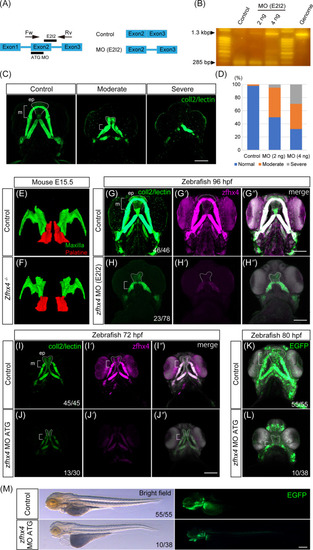
Morpholino (MO)‐based zfhx4 function loss led to craniofacial malformation in zebrafish. (A) Pre‐mRNA of zfhx4 and splicing MO design. Splicing MO (E2I2) was designed to bind to the exon 2 and intron 2 boundary. Presumptive zfhx4 mRNA inhibited by the MO (E2I2) showed splice site skipping between exon 2 and intron 2. (B) Splice‐blocking efficiency confirmation of the MO (E2I2) using reverse transcription‐polymerase chain reaction (RT‐PCR). Total RNA was isolated from the control and zfhx4 morphants at 1 day postfertilization. Forward and reverse primers were designed to target exons 2 and 3, respectively (A). PCR product length of the control was 285 bp, and the length of the splice‐inhibited products was 1305 bp. A single band was detected at the 285 bp length in the control. An unspliced product containing intron 2 was detected at the 1.3 kbp length in the zfhx4 morphants. This band was observed in the same position as the genomic PCR product. (C,D) Typical zfhx4 morphants exhibited moderate and severe craniofacial anomalies. (D). Frequency of the craniofacial anomalies in the zfhx4 morphants. (Control: N = 46, MO [E2I2] of 2 ng/embryo: N = 62, MO [E2I2] of 4 ng/embryo: N = 28). Phenotypic severity was observed with MO (E2I2) in a dose‐dependent manner, corresponding to the RT‐PCR result in Figure 4B. (E,F′) Three‐dimensional reconstructed maxillary (green) and palatine bones (red) in E15.5 control and Zfhx4 null embryos. Smaller maxillary and deformed palatine bones were observed in Zfhx4 null mice compared with their littermate controls. (G–H″) zfhx4 morphants displayed cleft palate and micrognathia (G,H). Effective functional zfhx4 inhibition was confirmed by decreased Zfhx4 expression via immunofluorescence staining (G–H″, Control: N = 46, MO [E2I2]: N = 78). ATG MO of zfhx4 showed craniofacial defects similar to those of E212 MO (I–L). (M) Overall morphology of zfhx4 morphant at 80 hpf. (Control: N = 45, ATG MO: N = 30 in I–J″). (Control: N = 55, ATG MO: N = 38 in K–M). ep, ethmoid plate; m, Meckel's cartilage. Scale bars: 100 μm.
|

